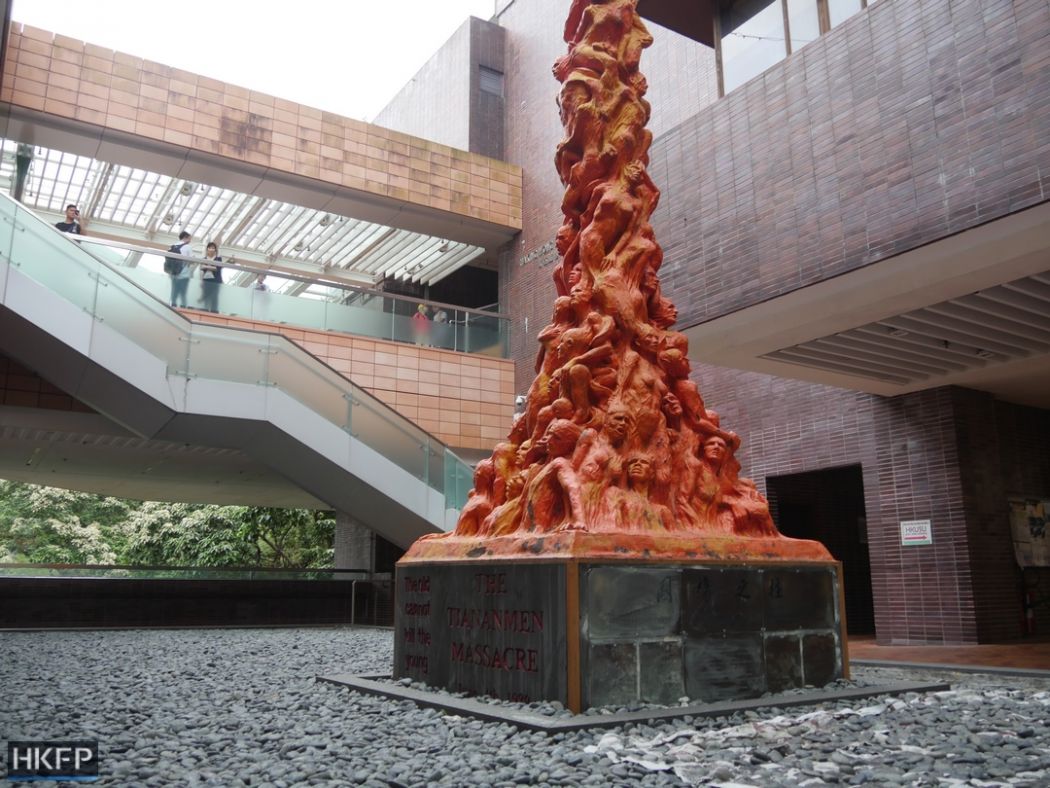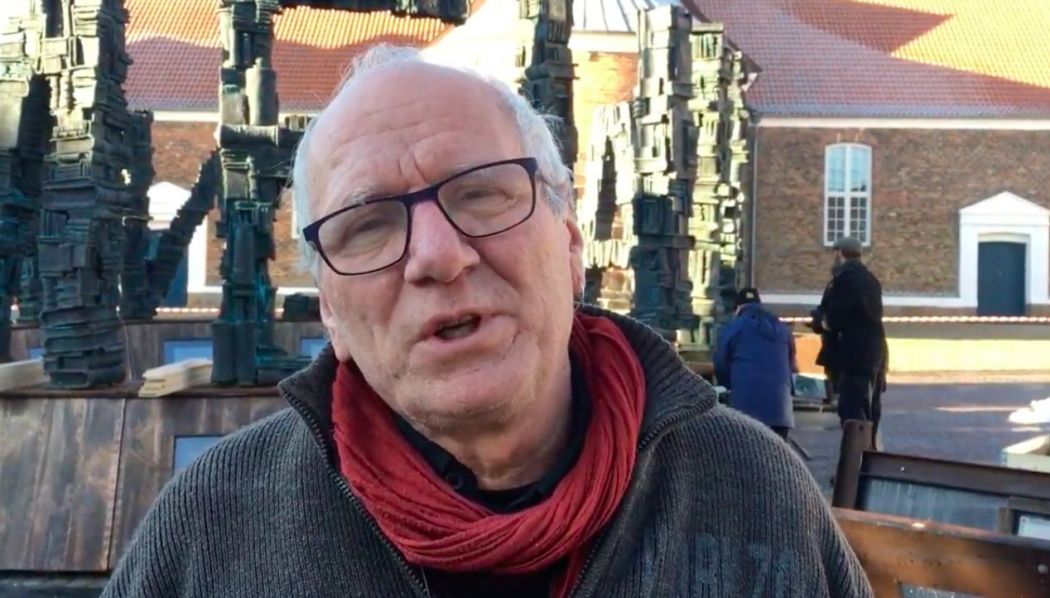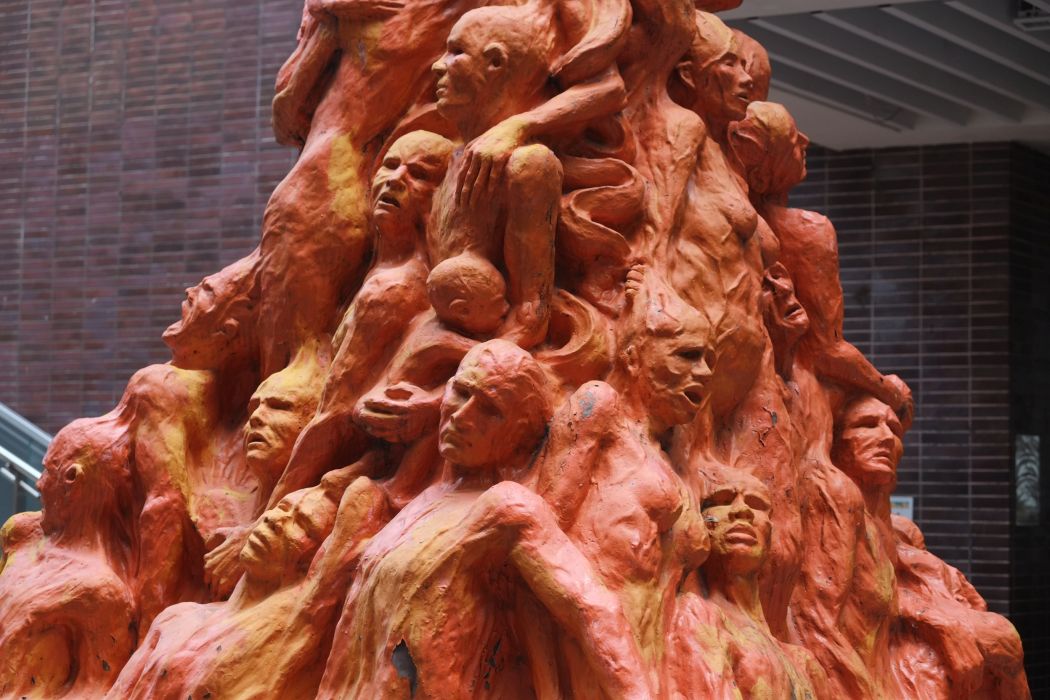Danish artist Jens Galschiøt, best known for his eight-metre tall sculpture The Pillar of Shame, has designed a highway sign that honours victims of the 1989 Tiananmen Square Massacre to mark 30 years since the crackdown. The three square metre sign was set up in April at an exit near the city of Odense in Demark and points to Galschiøt’s gallery.
The sign depicts seven silhouettes of sculptures by Galschiøt including Survival of the Fattest (2012), H.C. Andersen in a queer time (2012), Unbearable (2015), Freedom to Pollute (2002), In the name of God (2007) and My Inner Beast (1993), with The Pillar of Shame at the centre to mark 30 years since the crackdown.

Galschiøt, 64, told HKFP he included the harrowing Pillar of Shame statue in order to keep the memory of the crackdown alive. “It is because a lot of people don’t know about the massacre, people don’t talk about it as much anymore,” he said. “I want this to stimulate a discussion.”
The massacre occurred on June 4 1989, ending months of student-led demonstrations in China. It is estimated that hundreds, perhaps thousands, died as the People’s Liberation Army suppressed protesters in Beijing.
The sign cost 50,000 Euros (HK$437,710) and was funded by the public, who contributed by purchasing sculptures from Galschiøt. The funds were raised in 14 days owing, Galschiøt said, to widespread support for the cause.

The Pillar of Shame was created in 1996 and depicts a tower of mangled bodies to symbolise grief. The base of the sculpture is engraved with “The Tiananmen Massacre,” “June 4th 1989,” and “The old cannot kill the young forever” in both English and Chinese.
The monument was painted orange in 2008 in support of Galschiøt’s “The Colour Orange” campaign to highlight human rights abuses in China during the Beijing Olympic Games. The colour, according to the artist, was a mixture of red, representing Chinese dictatorship, and yellow, representing freedom and human rights.
Galschiøt was denied entry into Hong Kong in 2008 and 2009 while attempting to enter to paint the sculpture.
See also: The Pillar of Shame: The history of Hong Kong’s harrowing tribute to the Tiananmen massacre victims
Activists in Hong Kong hold an annual washing of the monument while observing a one-minute silence to commemorate victims of the massacre.

Three versions of The Pillar of Shame exist – in Hong Kong, Mexico and Brazil. Each is made of bronze, copper, and concrete respectively. The artist said that, of all his sculptures, he was most proud of the pillar because of its symbolism.
‘Most progressive’ sign
Galschiøt said the new sign is the “most progressive” in Denmark and he hopes tourists will observe it on the highway.

“It is a really strong symbol in the world and, you know, 100,000 cars will pass it every day,” the artist said. “Now the sign will be on the highway for the next 20 years and almost a billion cars will pass by it, and perhaps the passengers will send the Chinese students a loving thought and thus help remember this part of history.”
‘New insights’
Galschiøt said he and his team of over 10 workers were only able to create the sign owing to his country’s freedom of expression.
“I am happy to live in a country where one can see the value in art about social criticism, as well as have it on an official Danish highway, and on the hometown of Danish poet Hans Christians Andersen also, who even used his adventures to put focus on the absurdity of society,” he said. “Art must be used to create new insights into the world, and that is the kind of art that is on the sign.”

However, the sculptor said he was concerned about the erosion of freedoms in Hong Kong and a possible chilling effect on political artists: “I think China is taking over Hong Kong more and more,” he explained.
“The most important thing for an artist is to start discussions but if there is no room for expression then it is kind of like a castration for the artist.”
The Hong Kong Free Press #PressForFreedom 2019 Funding Drive seeks to raise HK$1.2m to support our non-profit newsroom and dedicated team of multi-media, multi-lingual reporters. HKFP is backed by readers, run by journalists and is immune to political and commercial pressure. This year’s critical fundraiser will provide us with the essential funds to continue our work into next year.

